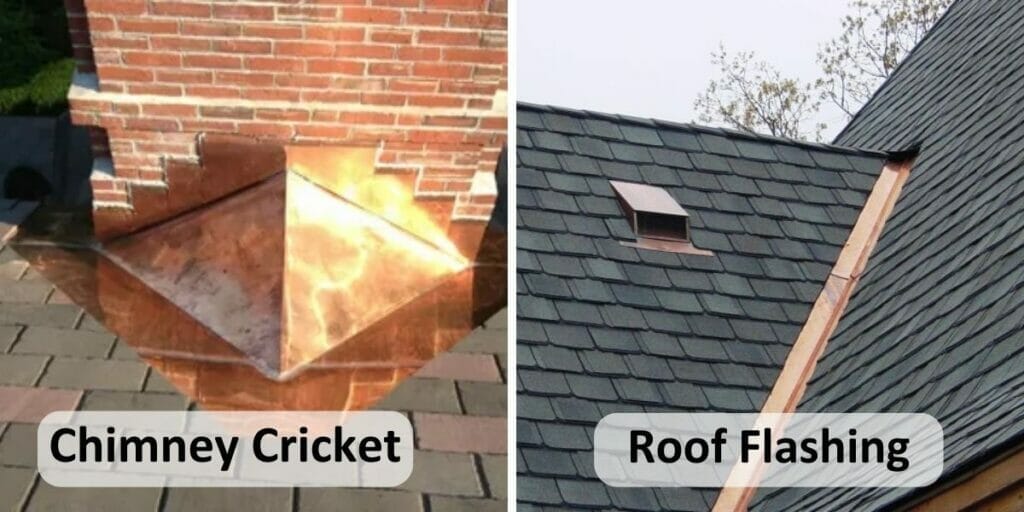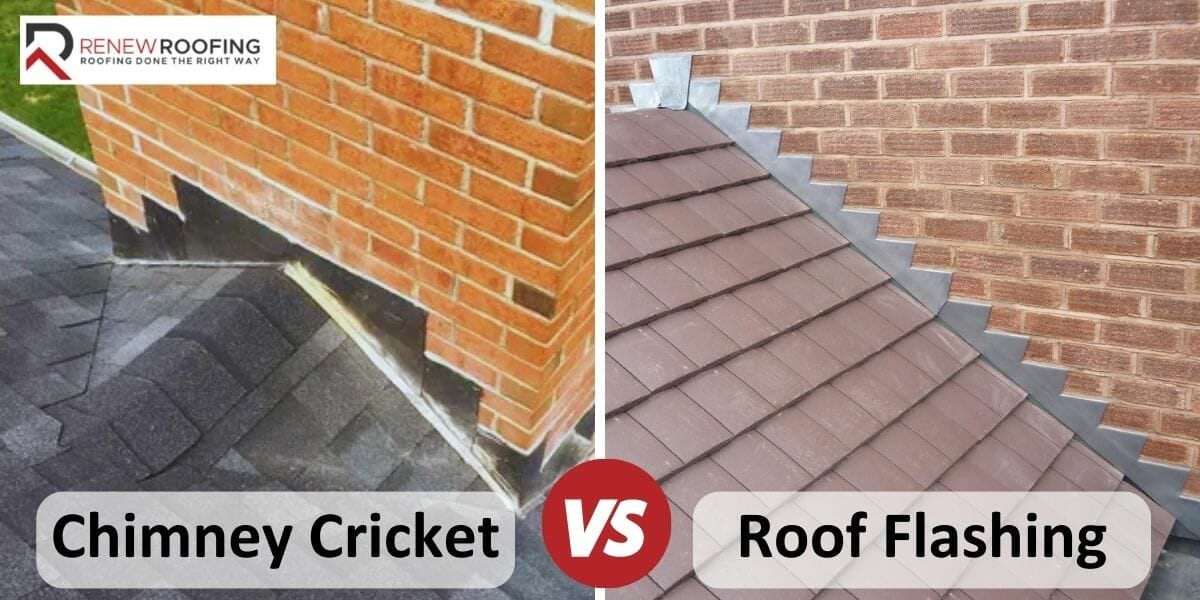When it comes to protecting your home from water damage, two critical components of your roofing system play a significant role – the chimney cricket and roof flashing. Both the chimney cricket and roof flashing serve distinct purposes, and understanding their differences can help you make informed decisions about your roofing needs. In this article, we will explore the differences between chimney cricket and roof flashing, highlighting their individual advantages and how they contribute to maintaining a leak-free and well-protected roof.
Understanding Chimney Crickets
#1 Definition and Purpose of a Chimney Cricket
A chimney cricket, also known as a chimney saddle, is a small ridge-like structure that’s a type of flashing and is built on the roof’s upward-sloping side of the chimney. Its primary purpose is to divert water away from the chimney and prevent water accumulation at the junction between the chimney and the roof. This is crucial in areas where heavy rainfall is common, much like how regular maintenance like Rohrreinigung Frankfurt is essential for ensuring plumbing systems function properly and prevent water damage inside a home. By redirecting water flow, chimney crickets protect the chimney and surrounding roof area from potential water damage and leaks.
#2 Common Materials Used
Chimney crickets are typically made from various materials, including:
- Wood: Wood crickets are often built on-site by skilled roofers using treated lumber to resist rot and decay.
- Metal: Metal crickets, usually made of copper or galvanized steel, offer durability and weather resistance.
- Synthetic Materials: Some modern roofers use synthetic materials such as vinyl for chimney cricket construction due to its lightweight and long-lasting properties.
Exploring Roof Flashing
#1 Definition and Purpose of Roof Flashing
Roof flashing is a critical component of a watertight roofing system, designed to prevent water from infiltrating vulnerable areas of the roof. It is typically made of metal, plastic, or rubber and is installed around roof penetrations, valleys, and joints to create a protective barrier against water intrusion. Similar to how effective roof flashing prevents water damage to a home, professional services like abflussreinigung Wien are essential for maintaining the integrity of plumbing systems, ensuring that drains are clear and functioning properly to prevent water backup and related issues. This synergy between external and internal water management systems is crucial for the overall maintenance and longevity of a building’s structure.
#2 Types of Roof Flashing Materials
Roof flashing materials can vary depending on the specific application and the climate in which the roof is located. Common types of roof flashing materials include:
- Galvanized Steel: Galvanized steel flashing is economically friendly and provides reliable protection against water.
- Aluminum: Aluminum flashing is lightweight, corrosion-resistant, and often used in coastal areas.
- Copper: Copper flashing offers superior longevity and develops a unique patina over time, adding aesthetic appeal.
- Rubber: Rubber flashing is commonly used for sealing roof penetrations and offers excellent flexibility and durability.

Key Differences Between The Chimney Cricket and Roof Flashing
To understand the unique characteristics of a chimney cricket and regular roof flashing, let’s examine their key differences:
| Aspects | Chimney Cricket | Roof Flashing |
| Purpose and Function | Diverts water away from the chimney, preventing pooling | Creates a watertight barrier around roof penetrations and valleys |
| Location and Placement | Installed on the uphill side of the chimney | Placed around roof penetrations, valleys, and joints |
| Materials and Design | Can be made of wood, metal, or synthetic materials | Typically made of metal, rubber, or plastic |
Chimney Cricket: Pros and Cons
Pros:
- Water Diversion: One of the main advantages of a chimney cricket is its ability to divert water away from the chimney. By creating a sloped surface, it ensures that water flows down the roof and into the gutters, preventing water from pooling around the chimney.
- Reduced Water Damage: With effective water diversion, a chimney cricket helps protect both the chimney and the surrounding roof area from potential water damage. By preventing water infiltration, it minimizes the risk of rot, decay, and structural issues caused by water exposure.
- Extended Roof Lifespan: By safeguarding the chimney and roof from water-related problems, a properly installed chimney cricket can contribute to the overall longevity of the roof. It helps maintain the roof’s structural integrity and preserves the roofing materials.
- Suitable for Sloped Roofs: Chimney crickets are particularly beneficial for homes with sloped roofs. They ensure water flows away from the chimney even during heavy rainfall or snowmelt, preventing water from accumulating around the chimney.
Cons:
- Installation Complexity: The installation of a chimney cricket requires precision and expertise. Improper installation can lead to water leaks and negate its intended purpose. It is essential to hire a skilled roofer to ensure the chimney cricket is correctly positioned and sloped.
- Maintenance: While chimney crickets reduce water-related issues, they still require regular maintenance. Leaves, debris, or even snow can accumulate on the cricket, hindering water flow. Regular inspections and cleaning are necessary to ensure it functions optimally.
Roof Flashing: Pros and Cons
Pros:
- Watertight Seal: Roof flashing creates a watertight barrier around roof penetrations and intersections, such as chimneys, vents, and valleys. It prevents water from infiltrating vulnerable areas of the roof, ensuring a leak-free roofing system.
- Versatility: Roof flashing comes in various materials, including galvanized steel, aluminum, copper, and rubber, offering versatility in terms of durability, weather resistance, and aesthetics. This allows homeowners to choose the most suitable material for their specific roofing needs.
- Prevents Water Damage: By effectively sealing vulnerable areas, roof flashing helps prevent water damage, such as rot, mold, and interior leaks. It protects not only the roofing materials but also the interior of the home.
- Longevity: Depending on the material used, roof flashing can have a long lifespan. Copper flashing, for example, can last for several decades, providing long-term protection for the roof.
Cons:
- Improper Installation Risks: Similar to chimney crickets, the effectiveness of roof flashing depends on proper installation. If not installed correctly, it can lead to water leaks and damage. Professional installation by a skilled roofer is crucial for ensuring a secure and watertight seal.
- Prone to Damage: Roof flashing, especially in areas with severe weather conditions, can be susceptible to damage over time. Harsh winds, extreme temperatures, or impacts can cause the flashing to degrade or loosen, compromising its effectiveness.
- Maintenance: While roof flashing requires less maintenance than chimney crickets, it still needs periodic inspections to ensure it remains intact and provides optimal protection. Any signs of wear or damage should be addressed promptly to prevent water infiltration.
Which One Should You Choose?
Choosing between a chimney cricket and regular roof flashing depends on your roofing needs and the specific areas that require protection.
- Chimney Cricket: If your roof has a chimney, a chimney cricket is essential to redirect water away and prevent water pooling. Chimney crickets are particularly beneficial in areas with frequent rainfall or snow.
- Roof Flashing: Roof flashing is crucial for protecting roof penetrations, valleys, and joints from water infiltration. If your roof has skylights, vents, or other roof penetrations, roof flashing is the ideal solution to maintain a leak-free roof.
To make an informed decision and ensure your roof stays leak-free and well-protected, check out our blog post: A Guide To Choosing The Perfect Roof Flashing Materials For Your Roofing System.
The Importance of Professional Installation
While some homeowners may attempt DIY installation of chimney crickets or roof flashing, it is crucial to recognize the importance of professional installation.
- Avoiding DIY Mistakes: Improperly installed chimney crickets or roof flashing can lead to water leaks and roof damage, defeating the purpose of having these protective components.
- Expertise of Roofing Contractors: Professional roofing contractors have the necessary skills and experience to install chimney crickets and roof flashing correctly. They ensure a watertight seal and maximum protection for your roof.
Conclusion
To ensure the effectiveness of both the chimney cricket and roof flashing, it is essential to seek professional installation from experienced roofing contractors. With their expertise, you can rest assured that your roof is well-protected and will continue to provide a secure shelter for your home.
At ReNew Roofing, we understand the significance of properly installed chimney cricket and roof flashing in safeguarding your roof and home from water-related issues. Our team of skilled roofing contractors is committed to providing top-notch installation services to ensure your roofing system stays secure and leak-free.
So, whether your roof has a chimney or various roof penetrations, chimney crickets, and roof flashing work together to keep your roof in top-notch condition, protecting your home for years to come. Don’t hesitate to contact us at (813) 400-3329 for professional installation and reliable roofing solutions. Your roof’s longevity and your home’s protection are our top priorities.
FAQs
A. Chimney crickets should be inspected during regular roof maintenance, which is typically recommended twice a year. Regular inspections ensure any wear or damage to the cricket can be addressed promptly.
A. Yes, roof flashing can be installed on an existing roof during repairs or roof replacements. Skilled roofing contractors can seamlessly integrate the flashing with the existing roof.
A. Not all chimneys require a chimney cricket. The need for a cricket depends on the roof’s slope, the size of the chimney, and the prevailing weather conditions in your area.
A. The lifespan of roof flashing depends on the material used and the quality of installation. Copper flashing can last for several decades, while other materials may have a shorter lifespan.
A. Yes, roof flashing is specifically designed to prevent leaks around skylights and other roof penetrations. Properly installed flashing creates a secure seal, protecting against water infiltration.






